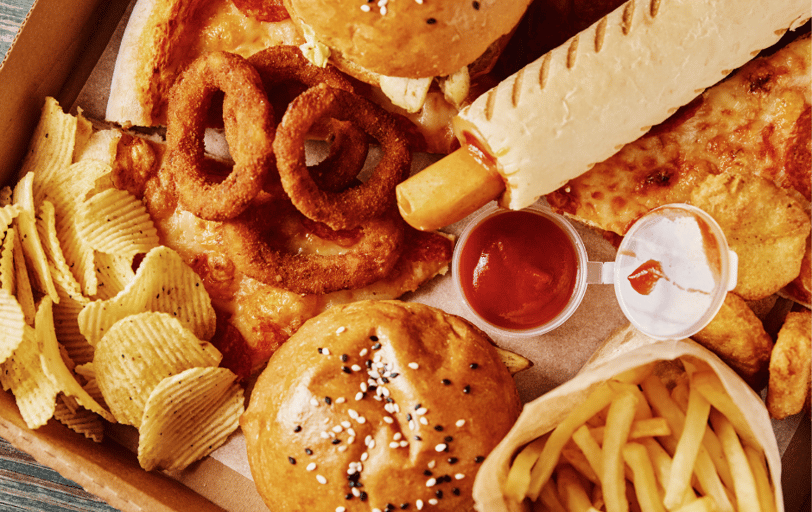Fast Food
Improve speaking- and writing skills with a focus on the enticing theme of fast food.
Hello, fellow EFL teachers! What part of the world are you in? In my current context, we changed the clocks to winter time. With lower temperatures, my dietary habits change too- and I need warm meals! So, in this post we’re going to explore a topic we can all relate to: Food, with a specific focus on the beloved world of fast food.
We’ll dive into some practical methods you can employ when teaching speaking and writing about fast food, to make learning fun and relatable for your learners. These methods aim to promote active participation, critical thinking, and linguistic development. So, read on, and let’s make teaching English a bit more delicious!


1. Authentic Materials and Visual Aids
To introduce the topic of food and fast food, utilize authentic materials such as menus, food advertisements, and recipe books. These materials offer real-world examples that students can connect with.
Additionally, incorporating visual aids such as images, videos, and infographics can stimulate students' interest and provide valuable context for discussion.
2. Role-Plays and Dialogues
Role-plays and dialogues are excellent tools to enhance speaking skills and encourage students to engage in conversations related to food.
You can create scenarios involving ordering food at a restaurant, discussing favorite dishes, or debating the pros and cons of fast food.
By assigning roles and providing prompts, students can practice the target language in a meaningful and interactive way.




3. Vocabulary Building Activities
Developing a rich vocabulary is crucial for effective communication.
Organize vocabulary building activities like word banks, matching exercises, and flashcard games.
Students can explore food-related words, such as ingredients, cooking methods, and descriptive adjectives.
These activities promote word association and improve students' ability to express their thoughts clearly.
4. Group Discussions and Debates
Group discussions and debates are effective methods to enhance speaking and critical thinking skills.
Divide the class into small groups and assign topics related to food and fast food.
Encourage students to express their opinions, support their arguments, and engage in respectful debates.
This activity fosters active participation, cooperation, and the development of persuasive language.


5. Writing Prompts and Essay Assignments
Writing assignments provide students with an opportunity to consolidate their thoughts and express themselves through the written word.
Give students writing prompts related to food, such as describing a favorite dish, sharing a personal food memory, or discussing the impact of fast food on health.
Encourage students to structure their essays with an introduction, body paragraphs, and a conclusion, focusing on coherence and clarity.
6. Real-Life Experiences
Taking learning beyond the classroom can greatly enhance students' language acquisition.
Organize field trips to local restaurants, food markets, or fast-food chains. This hands-on experience allows students to interact with native speakers, practice ordering food, and observe food-related conversations in real-life contexts.
It also provides opportunities for students to explore cultural aspects of food and expand their understanding of different cuisines






7. Multimedia Projects
Multimedia projects offer a creative outlet for students to demonstrate their language skills.
Assign projects that involve creating digital presentations, videos, or podcasts related to food and fast food as these projects encourage research, critical thinking, and the integration of various language skills.
Students can showcase their knowledge, present their findings, and express their opinions in an engaging and dynamic manner.
8. Cross-Curricular Integration
Integrating the topic of food and fast food across different subjects can reinforce vocabulary and language skills.
Collaborate with other teachers to incorporate food- related themes in subjects such as science, geography, or social studies.
For instance, students can explore the nutritional content of fast food, the impact of food production on the environment, or cultural practices related to traditional cuisines, in the form of a case-study.
This interdisciplinary approach facilitates a deeper understanding of the topic while enhancing language development.








Teaching speaking and writing about food and fast food to EFL students requires a multifaceted approach that combines authentic materials, interactive activities, and real-life experiences. By implementing any of the methods above we:
create an engaging and effective learning environment;
actively involve students and foster their language skills;
help students develop confidence and proficiency in expressing themselves in English while exploring the fascinating world of food.
Get this FREEBIE to begin discussion with your students about fast food! See you in the next post – stay well 😊
